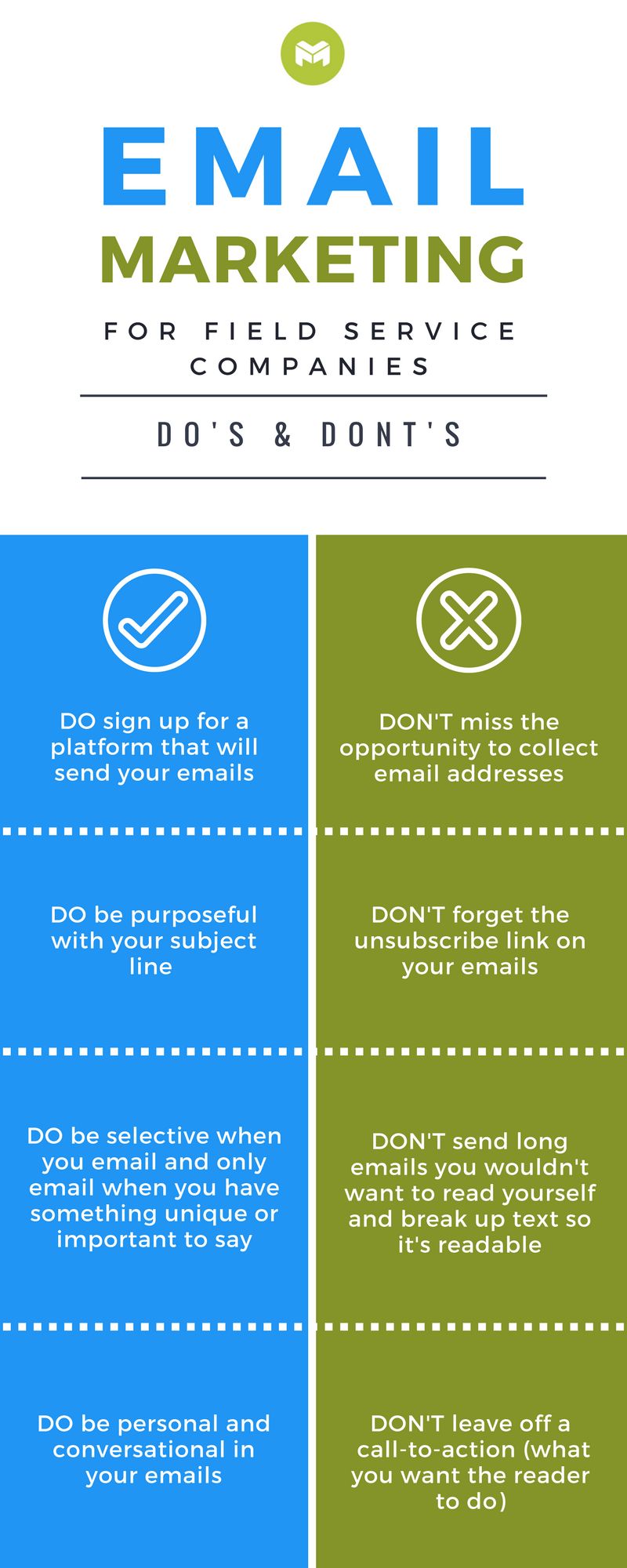“Email marketing drives more conversions than any other marketing channel, including search and social.” – Report by Monetate
Google “Email marketing stats” and you’ll come across many proof points that email marketing is a marketing channel that shouldn’t be ignored. For field service companies, especially those with a customer base who only seek them once or a couple times a year (think your plumbers, appliance repair or HVAC technicians), email marketing can help keep them top of mind with consumers. If you regularly email your customers throughout the year, the next time your customers’ appliance breaks or their pipe is clogged, the chances are good that your business will be the first to come to mind; the same goes for when they have a family member or friend who is in the market for service repair. As with any marketing channel, there are many best practices to be aware of with email marketing.

[Share this on Facebook, Twitter or Pinterest!]
Let’s dig into specifics for each email marketing best practice.
1. DO sign up for a platform that will send your emails
Email marketing is really the practice of sending out the same email to a list of customers or leads. Signing up for a platform that can send the emails for you will eliminate manual work and allow you to easily email customers or leads. We use Mailchimp here at mHelpDesk and like their simple interface, which makes it easy to design and build emails, along with reporting functionality, which gives you stats on how many people open and click your emails. The best part is they have a free plan, which you can use as long as you have 2,000 subscribers or less.
2. DON’T miss the opportunity to collect email addresses
A great way to start collecting a list of emails is by making sure to mention it to your customers immediately after you finish a job. This can be done in person or through a call-out on an invoice or thank you email. With the latter, you can direct them to your website to sign up to receive your promotions and newsletter, if you choose to put those together. A “Subscribe” button or section on your homepage is also important for potential new customers who might be attracted to promotions or discounts.
3. DO be purposeful with your subject line
Spending some time thinking about your subject line can make a big difference when it comes to how many people open your email. Work to make the subject line catchy and exciting, but concise. Evoking a sense of urgency is important as well.
There are many reports and studies around what subject line keywords help boost email open rates. Below are some of the top-performing keywords that are likely to be relevant for field service companies:
- “{First name}” – This refers to personalizing your subject line with your customer or lead’s first name (you can easily do this with an email platform like Mailchimp).
- “Invitation”
- “Introducing”
- “New”
- “Special” or “Specials”
- “News”
- “Sale” or “Sale!”
- “Events”
- “Offer” or “Offers”
- Upgrade”
- “Alert”
- “Thank you”
- “Get This Now” or “Get Your”
- “Can…?”
Here’s a great resource from OptInMonster.com on perfecting your subject lines. At the end of the day, success with subject lines really depends on your audience, so see what works. Email platforms like Mailchimp will allow you to gain good insights when you test out your subject lines.
4. DON’T forget the unsubscribe link on your emails
It’s not only good practice to include an unsubscribe link on all your emails, it’s a legal requirement that email subscribers be able to easily unsubscribe (or opt-out) from your emails. Email platforms will have this already built in for you, which makes your job easy.
5. DO be selective when you email and only email when you have something unique or important to say
When thinking about how often you should email your customers or leads, you want to make sure that you don’t overwhelm them, either with too many emails or by sending them emails they’re not interested in, so that they don’t unsubscribe from your mailings. Chances are you won’t be running promotions every week, so you shouldn’t have too much to worry about. If you’re considering a newsletter that covers general updates about your business or care and maintenance tips, we recommend running those monthly or every other week.
6. DON’T send long emails you wouldn’t want to read yourself and break up text so it’s readable
If the subject line gets people to open emails, email content gets them to stay and read the content. If your email is too long, most consumers will quickly close out the email. Consider this stat: The average adult’s attention span is 8.25 seconds (StatisticBrain.com). Your job as marketer is to communicate your message to them in a direct and concise way; the less words, the better! The most important part of your message should be at the top of the email as well. Finally, a good practice is to break up your content into short paragraphs and utilize bullet points, so people can easily scan your email.
7. DO be personal and conversational in your emails
Consumers in general will be more interested in messaging (or wording) that is less corporate and more conversational. A good approach is to write as if you are a friend telling them about a deal or tip you saw.
Personalizing your email by addressing it to the specific customer or lead is a must. Email platforms will allow you to do this easily so your emails can start with “Hi Sally,” vs. “Hi Customer,”.
8. DON’T leave off a call-to-action (what you want the reader to do)
Every email (and really every piece of marketing, whether it’s a website, brochure or ad) should have a call-to-action (or CTA), which is essentially what you want the customer or lead to do. For field service companies, some examples of call-to-actions on emails are: “Call now”, “Schedule your appointment”, “Approve”, “Pay now”, “Read the blog post”, “Subscribe”, or “Refer a friend.”
Found this post to be helpful? Email this to your team or share it on social media! And stay tuned for a follow-up to this post later this month! We’ll cover more email marketing do’s and don’ts. If there’s specific advice you’re looking for regarding email marketing for field service companies, just leave us a comment below.
Read Part 2 of “Email Marketing for Field Service Companies: Do’s & Don’ts” >>
Last modified: April 6, 2018








